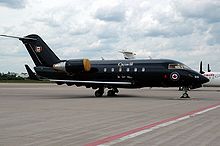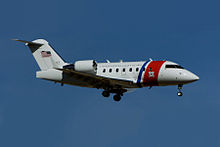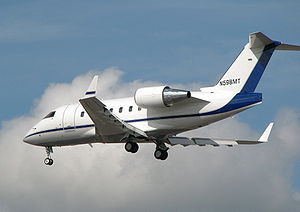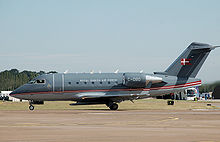- Bombardier Challenger 600
-
"Canadair Challenger" redirects here. For other uses, see Bombardier Challenger (disambiguation).
Challenger 600/601/604/605 Bombardier CL-604, built 2001 Role Business jet Manufacturer Bombardier Aerospace First flight 8 November 1978 Status In production Unit cost Around US$25 million Developed into CRJ-100/200 The Bombardier Challenger 600 series is a family of business jets designed by Bill Lear and produced first by Canadair until that company was bought by Bombardier Aerospace in 1986.
Contents
Development
The aircraft was an independent design by Bill Lear in 1976, who had resigned as Chairman of Lear Jet seven years previously. Originally dubbed the LearStar 600, Lear sold exclusive rights to produce and develop the design to Canadair, who renamed it the CL-600 Challenger.
While similar in general configuration to Lear's previous designs, notable changes were made that distinguished the new aircraft from the Learjets, including the use of a widened fuselage that allowed a "walk-about cabin", a feature not shared by any other business aircraft of the time. The Challenger was also one of the first bizjets designed with a supercritical wing.
On 8 November 1978, the prototype aircraft took off at Montreal, Canada. The second and third prototypes flew in 1979. A 3 April 1980 test flight in the Mojave Desert resulted in disaster, the aircraft crashing due to a deep stall, killing one of the test pilots (the other test pilot and the flight test engineer parachuted to safety).[1]
Despite the crash, both Transport Canada and the Federal Aviation Administration in the United States certified the aircraft in 1980, albeit with restrictions to pilots including a limited maximum take-off weight. A program to reduce the aircraft's weight was then implemented to improve the aircraft's range.
Challengers can be identified visually by their distinctive fowler flap design, where the fairings can be seen below the wings, a sight much more common on commercial airliners.
Variants
CL-600
- CL-600: original production version, powered by Avco Lycoming ALF 502L turbofans of 7,500 lbf (33.6 kN) thrust each. Built until 1983 (83 built)
- CL-600S: 76 CL-600s retrofitted with the winglets introduced on the CL-601-1A. 12 aircraft purchased by the Royal Canadian Air Force, named CC-144, CE-144, and CX-144.
CL-601
- CL-601-1A: refined version including winglets to reduce drag and more powerful General Electric CF-34 engines. (66 built, including 4 Canadian Forces CL-144/ CC-144B)[2]
- CL-601-1A/ER: 601-1A retrofitted with an additional fuel tank in the tail
- CL-601-3A: engine with a higher flat rating and a glass cockpit. This was the first version marketed by Bombardier.
- CL-601-3A/ER: 601-3A with an additional, optional fuel tank in the tail
- CL-601-3R: the tail tank was made standard, and airline style "unsided" engines (no left or right) were used, matching what was used on the CRJ.
CL-604
- CL-604: major upgrade of the 601 design, incorporating more powerful engines, larger fuel supply, including saddle tanks in the rear of the aircraft, new undercarriage for a higher takeoff and landing weight, structural improvements to wings and tail, and a new Collins ProLine 4 avionics system. The C-143A is a single Challenger 604 aircraft, which was acquired by the United States Coast Guard in December 2005 as its new Medium Range Command and Control Aircraft (MRC2A).[3]
CL-605
- CL-605: introduced in early 2006 as an avionics and structural upgrade of the 604 design. Structural improvements include larger cabin windows. Cockpit instrumentation updated with the Collins Proline 21 avionics and "electronic flight bag" capability. It can be visually identified by a new, rounded tailcone.
CL-610
The CL-610 Challenger E was to have been a stretched version for use as a cargo plane by Federal Express, or alternatively, as a passenger aircraft with seating for 24 passengers.[7] Federal Express placed orders for 25 CL-610s, but these orders were canceled after the passage of air cargo deregulation in the US in 1977.[8] Development was halted by Canadair in 1981 without any having been built. A few years later, a new project would develop the Canadair Regional Jet based on a stretched Challenger design.
Operators
Military operators
 The Challenger 601 is used to transport the Governor General, government officials, foreign dignitaries and the Prime Minister using the designation CC-144 Challenger.
The Challenger 601 is used to transport the Governor General, government officials, foreign dignitaries and the Prime Minister using the designation CC-144 Challenger.
 U.S. Coast Guard VC-143 Challenger provides VIP transport for high-ranking members of the Department of Homeland Security and U.S. Coast Guard using the designation Coast Guard 02.
U.S. Coast Guard VC-143 Challenger provides VIP transport for high-ranking members of the Department of Homeland Security and U.S. Coast Guard using the designation Coast Guard 02.
- Royal Canadian Air Force: designated as the Bombardier CC-144 Challenger
- No. 412 Squadron
- No. 434 Squadron (former)
- Croatian Government (EMS and VIP Transport)
- United States Air Force
- United States Coast Guard: designated as the Bombardier VC-143 Medium Range Command and Control Aircraft.[9]
Civilian operators
- Morningstar Partners Ltd.: Operates one CL605 as part of fractional fleet.
- Government of the Czech Republic: Former operator
- Government of Croatia: Former operator
- Government Flying Service: Operates two CL605s as part of fractional fleet.
- Government of Jordan
- Hornbill Skyways (One CL-605; for state executive flight)
- VistaJet Holding
- Nomad Aviation
- Rega air rescue, operates three CL604s
Specifications (CL-601-3A)
Data from [10]
General characteristics
- Crew: Two (pilot & co-pilot)
- Capacity: Up to 19 passengers, depending on configuration
- Length: 20.85 m (68 ft 5 in)
- Wingspan: 19.61 m (64 ft 4 in)
- Height: 6.30 m (20 ft 8 in)
- Wing area: 48.3 m² (520 ft²)
- Empty weight: 9,292 kg (20,485 lb)
- Loaded weight: 19,618 kg (43,250 lb)
- Useful load: 1,814 kg (4,000 lb)
- Max takeoff weight: 19,550 kg (43,100 lb)
- Powerplant: 2 × General Electric CF34-3A turbofans, 40.7 kN (9,140 lbf) each
Performance
- Maximum speed: 882 km/h (476 knots, 548 mph)
- Cruise speed: 851 km/h, (459 knots, 529 mph)
- Range: 6,236 km (3,366 nm, 3,875 mi)
- Service ceiling: 12,500 m (41,000 ft)
- Rate of climb: 1,355 m/min (4,450 ft/min)
See also
- Related development
- Aircraft of comparable role, configuration and era
References
- ^ Check-Six.com - the Crash of Challenger #1001
- ^ CF Challengers
- ^ DOD 4120.15-L - Addendum
- ^ a b "Update: Denmark's Arctic Assets and Canada's Response — Danish Air Force Aircraft on a Mission over Canada's High Arctic". Canadian American Strategic Review. 2009-07. http://www.casr.ca/id-arcticviking-challenger.htm. Retrieved 2009-07-12.
- ^ a b "Canadian Aerospace – Background – Challenger 604 MMA". Canadian American Strategic Review. http://www.casr.ca/bg-aerospace-challenger-604-mma.htm. Retrieved 2009-07-12.[dead link]
- ^ "Update: Denmark's Arctic Assets and Canada's Response — Danish Air Force Aircraft on a Mission over Canada's High Arctic". Canadian American Strategic Review. Archived from the original on 2009-10-11. http://www.webcitation.org/query?url=http%3A%2F%2Fwww.casr.ca%2Fid-arcticviking-challenger.htm&date=2009-10-11. Retrieved 2009-07.
- ^ Logie 1993
- ^ "Federal Express: the Memphis Connection" Flight International April 4, 1981.
- ^ USCG: Air Station Washington DC
- ^ Lambert, Mark (1993-1994). Jane's All The World's Aircraft (1993-94). pp. 27–28. ISBN 0-7106-1066-1.
- Bibliography
- Logie, Stewart. Winging It: The Making of the Canadair Challenger. Macmillan of Canada, June 1993. ISBN 0771591454.
External links
- Bombardier Challenger 605 Official website
- Canadian Forces CC-144 Challenger website
- Challenger 600 series on Smartcockpit.com
Bombardier aircraft Turboprop aircraft 415 · Q-Series
Learjet family Challenger family Global family Global 5000 · Global Express · Global Express XRS · Global 7000 · Global 8000
CRJ family CSeries UAVs CL-327
See also: Canadair · de Havilland Canada · Learjet · Short Brothers Canadair aircraft models Unmanned Piston-engined North Star · CL-16 · CL-28 · CL-66 · CL-215
Turboprops Jets See also: Bombardier Aerospace · Canadian Vickers Canadian Forces unified aircraft designations post-1968 100-125 126–150 151- Lists relating to aviation General Aircraft (manufacturers) · Aircraft engines (manufacturers) · Airlines (defunct) · Airports · Civil authorities · Museums · Registration prefixes · Rotorcraft (manufacturers) · TimelineMilitary Accidents/incidents Records Categories:- Bombardier aircraft
- Canadian business aircraft 1970–1979
- Canadair aircraft
- CL-600: original production version, powered by Avco Lycoming ALF 502L turbofans of 7,500 lbf (33.6 kN) thrust each. Built until 1983 (83 built)
Wikimedia Foundation. 2010.




